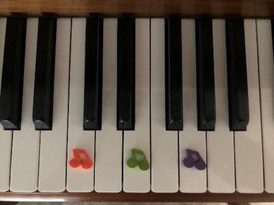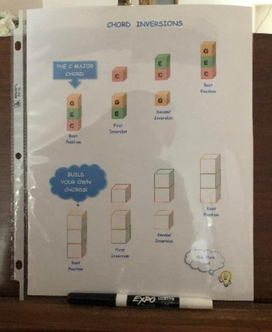Submitted by Miriam Shingle
Perhaps your piano students don’t have trouble visualizing chord inversions on the keys, but chances are some do. There is a fun and easy way to help them!
Manipulatives and colors are always attractive means to practice or introduce concepts, and are a great way to introduce inversions of chords. I like to start with the C chord and use erasers on the keys, a different color for each note:
Perhaps your piano students don’t have trouble visualizing chord inversions on the keys, but chances are some do. There is a fun and easy way to help them!
Manipulatives and colors are always attractive means to practice or introduce concepts, and are a great way to introduce inversions of chords. I like to start with the C chord and use erasers on the keys, a different color for each note:

You can of course use any erasers….or other objects that are large enough so that they won’t fall between the keys. Sticky flags work well, too, and are less likely to get in the way when the students play the chords.
Simply “leap-frog” the erasers or objects into the different inversion positions. Students can place their fingers on the “eraser keys” to play. Have the students try moving the erasers to the correct positions as a good evaluation tool to see if they can do it on their own.
Simply “leap-frog” the erasers or objects into the different inversion positions. Students can place their fingers on the “eraser keys” to play. Have the students try moving the erasers to the correct positions as a good evaluation tool to see if they can do it on their own.

I also created a fun visual for spelling chord inversions, which you can use for either online or in-person lessons. (And it helps reinforce how to spell basic chords.) Notice that the “building blocks” are also color-coded. MLMTA members: you can download this Chord Inversions document on this website under Member Resources – YAY!
If you’re like me and still have a few online students, simply share your screen to display the document. Then you and the student can use Zoom’s annotation tool to fill in the blocks.
For in-person lessons, print it out on thick paper or cardstock, and place it in a clear sheet protector to use with a dry-erase marker. Either way, it’s convenient and tree-friendly!
Please COMMENT to share how YOU like to teach chords or inversions!
If you’re like me and still have a few online students, simply share your screen to display the document. Then you and the student can use Zoom’s annotation tool to fill in the blocks.
For in-person lessons, print it out on thick paper or cardstock, and place it in a clear sheet protector to use with a dry-erase marker. Either way, it’s convenient and tree-friendly!
Please COMMENT to share how YOU like to teach chords or inversions!

 RSS Feed
RSS Feed